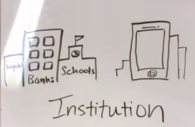The New Institution
Paul Sohn
[This video is available to students and instructors in the English 100 Program through Kaltura]
Writer’s Memo
The composition process of the Multimodal video was different from what I’ve done before, yet very enjoyable. I designed this video by drawing images on a whiteboard with a black erasable marker and inserting a voice over in the background like what AsapScience does on YouTube. The idea to construct my video is such a way was inspired by Naomi after our conversation about my struggle to find a way to effectively present my research. My presentation addresses the interests of anyone who uses Uber on a daily basis, anyone who is interested in psychology and general economics, or both. This form of argument may be more suited to starting conversations I’d like to initiate using my research because it is streamlined enough to capture the audience’s attention, but compact enough to deliver the big ideas to them. Utilizing this form of argument requires a lot of artistic skill and a concisely thinking mind, which could serve as a limitation. However, time is the most crucial constraint of this project: including only the most essential information in a time frame of 1 –2 minutes is very challenging. I used a casual tone operating this video because I want my audience to be relaxed when viewing it. Plus, there’s no component that could provoke sadness or anger among people, so keeping it casual is appropriate. However, by no means did I make the presentation monotone; I made sure to ask rhetorical questions and implement vibrancies in my voice to make the content appealing. I can imagine seeing this video popping up in my social medias’ new feeds. I can also see it being presented as a short series by AsapScience. The limitation of the research presented in this form is that I can’t talk about the process of external influences constructing trust in detail. A large portion of my research essay is on this aspect of the topic, but I can’t go over it because of the time constraint, like mentioned before. Since this presentation contains a narrative done by a voice-over, there is a possibility that someone may misconstrue the video by inserting their own version of a narrative and changing the meaning of the images drawn throughout the content. Moving on, I can understand the video having the possibility of being detrimental to people who are not familiar with Uber or smartphone devices, since their appraisal systems, or rating systems, are crucial to understanding the video. However, I have no worries regarding this matter because most of the students in the University of Wisconsin-Madison area are exposed to both. Overall, I am feeling confident about the quality of my video and the audience it can reach out to.
— Paul Sohn
Instructor’s Memo
Paul’s multimodal project takes up an element of his Sequence 3 persuasive research project. Our multimodal assignment provided a limited time range for students to work with, something that presented a challenge. After spending many weeks pursuing a research topic, students had a lot of exciting information at their fingertips, but they needed to reframe and limit their written argument if they were going to create a compelling video. In this project, Paul has done a great job of pulling out a couple of key threads that appear his larger argument and presenting them in ways that differ from his written essay’s approach. Instead of trying to cover all of the sub-claims in his paper, Paul focuses on two separate arguments that he encounters in his research, paraphrases the relevant points, and then shows how these perspectives fit together to support his larger point.
Something I find especially compelling about this project is the way Paul uses visual elements to add nuance to his claims. For instance, near the end of this video, Paul repeats an image he has drawn in an earlier frame: the basic shapes of several institutional buildings. This time, however, he draws a large cell phone next to them. This image works at a design level because he Paul used similar shapes to draw the buildings and the phone, but it also works as a visual metaphor that reinforces his claim—cell phones now loom large in our daily lives.
What may be invisible to viewers encountering this kind of video for the first time is the large amount of work that happens behind the scenes. Though Paul’s primary materials are simple—a whiteboard and pen—his planning process was complex. He had to storyboard the images he planned to use in his project. This meant experimenting with different images and transitions and discussing his plans with peers during an in-class workshop. In addition to composing his spoken script, Paul had to think about coordinating his visual elements with his spoken elements in ways that kept his audience engaged without distracting them. He also considered what kind of music he wanted in the background. As he reflects in his multimodal memo, Paul wanted his audience to feel relaxed but interested, and he has chosen cheerful, open-licensed instrumental music to accompany his work. As I watch this video, I can see how Paul’s motivation to refine both his script and visual storyboard until he was happy with them has made a difference in his work.
— Naomi Salmon
Student Writing Award: Multimodal Project (2018)


